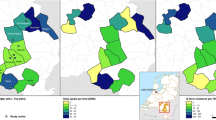Abstract
In spring 1996, an outbreak of Q fever occurred among residents of a rural town (population: 300) in Germany. A retrospective cohort study was conducted to ascertain the extent of the outbreak and to assess potential risk factors for illness. In July 1996, all residents ≥ years received a self-administered questionnaire and were offered Coxiella burnetii antibody testing. Residents were considered to have probable Q fever if they had a positive result for IgM C. burnetii antibodies by ELISA or possible Q fever if they had fever ≥39 °C lasting >2 days and ≥3 symptoms (chills, sweats, severe headache, cough, aching muscles/joints, back pain, fatigue, or feeling ill) after 1 January 1996. Two hundred (84%) of the 239 residents aged ≥15 years either completed the questionnaire or submitted blood for antibody testing. Forty-five (23%) of these 200 met the probable or possible case definitions. Onsets of illness occurred in January–June 1996. Cases were geographically distributed throughout the town. Persons reporting contact with sheep (32% vs 18%, RR: 1.8, 95% CI: 1.1–2.9) and walking near a large sheep farm located next the town (34% vs 8%, RR: 4.5, 95% CI: 1.7–12.2) were more likely to have met the case definition than those without these exposures. Fifteen of 20 samples from the large sheep flock were positive for C. burnetii antibodies. The sheep had lambed outdoors in December 1995–January 1996 while the weather was extremely dry. The timing of the outbreak after lambing, the uniform distribution of cases thoughout the town and the absence of risk factors among most case-persons suggest airborne transmission of C. burnetii from the large sheep farm.
Similar content being viewed by others
References
Marrie TJ. Coxiella burnetii (Q fever). In: Mandell GL, Bennett JE, Dolin R (eds), Principles and practice of infectious diseases. Vol. 2, 4th ed. New York: Churchill Livingstone, 1995: 1727–1735.
Aitken ID, Bögel K, Cracea E, et al. Q fever in Europe: Current aspects of aetiology, epidemiology, human infection, diagnosis and therapy. Infection 1987; 15: 323–327.
Raoult D, Marrie T. Q fever. Clin Infect Dis 1995; 20: 489–496.
Pebody RG, Wall PG, Ryan MJ, Fairley C. Epidemiological featurs of Coxiella burnetii infection in England and Wales: 1984 to 1994. Communicable Disease Report 1995; 6: 128–132.
Meiklejohn G, Reimer LG, Graves PS, Helmick C. Cryptic epidemic of Q fever in a medical school. J Infect Dis 1981; 144: 107–113.
Hall CJ, Richmond SJ, Caul EO, Pearce NH, Silver IA. Laboratory outbreak of Q fever acquired from sheep. Lancet 1982 (i): 1004–1006.
Salmon MM, Howells B, Glencross EJG, Evans AD, Palmer SR. Q fever in an urban area. Lancet 1982 (i): 1002–1004.
Sawyer LA, Fishbein DB, McDade JE. Q fever: Current concepts. Rev Infect Dis 1987; 5: 935–946.
Schneider T, Jahn HU, Steinhoff D, et al. Q-Fieber-Epidemie in Berlin: Epidemiologische und klinische Aspekte. Dtsch Med Wschr 1993; 118: 689–695.
Dupuis G, Petite J, Peter O, Vouilloz M. An important outbreak of human Q fever in a Swiss alpine valley. Int J Epidemiol 1987; 16: 282–287.
Smith DL, Ayres JG, Blair I, et al. A large Q fever outbreak in the West Midlands: Clinical aspects. Resp Med 1993; 87: 509–516.
Manfredi Selvaggi TM, Rezza G, Scagnelli M, et al. Investigation of a Q-fever outbreak in Northern Italy. Eur J Epidemiol 1996; 12: 403–408.
Welsh HH, Lennette EH, Abinanti FR, Winn JF. Airborne transmission of Q fever: The role of parturition in the generation of infective aerosols. Annals of the New York Academy of Science 1957; 70: 528–540.
Schmeer N, Krauss H, Werth D, Schiefer HG. Serodiagnosis of Q fever by enzyme-linked immunosorbent assay (ELISA). Zbl Bakt Hyg 1987; A 267: 57–63.
Lilienfeld AM, Lilienfeld DE, eds. Foundations of Epidemiology, 2nd ed. New York/Oxford: Oxford University Press, 1980.
Marrie TJ, Stein A, Janigan D, Raoult D. Route of infection determines the clinical manifestations of acute Q fever. J Infect Dis 1995; 173: 484–487.
Author information
Authors and Affiliations
Rights and permissions
About this article
Cite this article
Lyytikäinen, O., Ziese, T., Schwartländer, B. et al. An outbreak of sheep-associated Q fever in a rural community in Germany. Eur J Epidemiol 14, 193–199 (1998). https://doi.org/10.1023/A:1007452503863
Issue Date:
DOI: https://doi.org/10.1023/A:1007452503863




